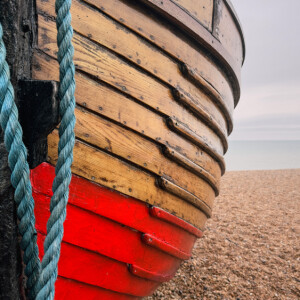Deal Seafront & Hut 55
Sunday morning: a grey, foggy, damp start to the day… not exactly great for a hike. The Steely-Eyed Ninja Speed Walkers gathered in Deal at the Route One cafe by the pier. The plan was a 10k walk along the seafront to Kingsdown and back, but after about 4.5k, it started to rain quite heavily, so we turned back a little early. The company was good, and there were plenty of photo opportunities along the way. As we neared the finish, we were tempted into Hut 55, a great pop-up cafe on the Deal & Walmer promenade that sells excellent coffee, massive sausage rolls and offensively large scotch eggs.
Thanks to Anna, Marcus, Charlotte, Caroline and Pasha for coming along on the walk today.
Deal Seafront in East Kent encapsulates a maritime legacy shaped by centuries of coastal activity. Its landscape combines a functional fishing beach, piers, and artistic installations that collectively narrate the town’s enduring relationship with the sea. Once a vital hub for ships anchored offshore, the seafront has transitioned into a leisure destination while preserving its working fishing traditions. This duality is reflected in its distinctive geography, historical architecture, and cultural practices that continue to define the area.
The geographical peculiarities of Deal’s coastline have played a critical role in its development. The absence of a natural harbour was offset by the sheltered anchorage of The Downs, positioned between the shore and the treacherous Goodwin Sands. These shifting sandbanks, notorious for shipwrecks, paradoxically protected vessels navigating the Channel. By the 12th century, Deal’s strategic importance was formalised through its inclusion in the Cinque Ports confederation, granting it tax exemptions in exchange for naval support. Unlike neighbouring Sandwich, which declined due to coastal silting, Deal thrived, emerging by the 18th century as one of England’s principal ports.
The seafront’s history is marked by its association with smuggling, a practice so entrenched that Prime Minister William Pitt the Younger ordered the burning of Deal’s smuggling vessels in 1790. Despite such measures, smuggling persisted, with local communities openly resisting authorities. In 1801, residents clashed with revenue officers attempting to seize a smuggling ship, underscoring the trade’s deep-rooted presence.
Deal Pier, a prominent feature of the seafront, has undergone three distinct phases. The first, constructed in 1838, was abandoned incomplete due to financial constraints and destroyed by storms in 1857. Its successor, designed by Eugenius Birch in 1864, exemplified Victorian engineering with ironwork, tramways, and a concert pavilion. Maritime collisions and wartime damage, including a 1940 incident involving a Dutch freighter, led to its eventual demolition. The current pier, opened in 1957 by the Duke of Edinburgh, introduced modern steel-and-concrete construction while retaining its predecessors’ role as a leisure and angling site. At 313 metres long, it was designed by Sir W. Halcrow and Partners and is the last remaining fully intact leisure pier in Kent. It includes a modern restaurant at the pier head, which opened in 2009 and won several architectural awards.
Artistic elements along the seafront reinforce Deal’s maritime identity. A bronze fisherman statue at the pier entrance symbolises the town’s fishing heritage. It is officially titled Embracing the Sea and was created by artist Jon Buck and unveiled in 1998. It stands at the entrance to Deal Pier and reflects the town's deep connection to its maritime history. At the same time, a removed wave sculpture, once adorning the pier clock, sparked community campaigns for its restoration. Local historian Helga Wood highlighted its cultural significance, noting its frequent depiction in art and photography. Following a public petition, plans were announced to reinstate the sculpture, reflecting its status as a cherished local emblem.
Deal’s fishing traditions remain vital, with techniques adapted to its shingle beach. Historical accounts describe intricate methods using ash sticks and weighted lines to cast bait into deeper waters. Seasonal variations yield diverse catches: winter brings dabs and whiting, while summer sees bass and mackerel. Specific locations, such as groynes near Sandown Castle, are noted for their productivity, a reputation documented since the 19th century. John Bickerdyke’s 1887 writings praised Deal as an exceptional angling destination, a sentiment echoed in 20th-century guides that celebrated its varied fish populations.
Culturally, the seafront has long been the town’s focal point. Historically home to a maritime workforce, Deal thrived during naval mobilisations, with anchored fleets stimulating local commerce. Architectural traces of this past endure in the irregular layout of seafront streets, where buildings still bear the brunt of coastal storms.
Deal Seafront today represents a continuity of maritime heritage. Its pier, fishing practices, and artistic landmarks collectively preserve a legacy of adaptation and resilience. As a historical site and a living workplace, it maintains a tangible connection to the sea, embodying a coastal identity forged over centuries. The interplay of tradition and evolution ensures that Deal’s seafront remains not merely a backdrop but an active participant in the town’s ongoing narrative.




Comments
Sign in or get an account to comment.


